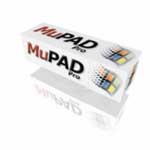 MuPADby SciFace
MuPAD Pro is a full-fledged computer algebra system for symbolic and numeric computing. Beside the common features of all MuPAD versions, MuPAD Pro for Windows offers some highlights for doing mathematics as easy as possible with the conviences of mouse and keyboard.
MuPAD Pro is a full-fledged computer algebra system for symbolic and numeric computing. Beside the common features of all MuPAD versions, MuPAD Pro for Windows offers some highlights ? especially a user-friendly interface ? for doing mathematics as easy as possible with the conviences of mouse and keyboard.
- Notebook Concept
A Notebook is the basic part of MuPAD Pro. It combines mathematical computations, advanced text processing and inline graphics in one document. In a Notebook you can re-edit and re-evaluate existing MuPAD expressions.
Multiple independent Notebooks can be opened at once, and Notebooks can be exported to RTF, plain text and HTML documents.
- Source code editor
MuPAD Pro for Windows includes a source code editor for writing user-defined procedures with syntax coloring and bookmark management.
- Source Code Debugger
A powerful tool for step-by-step execution of MuPAD procedures. It displays used variables and allows evaluation of arbitrary expressions during debugging.
- Interactive Graphics Tools News in 3.0
The Virtual Camera (VCam) for 2D and 3D visualizations of functions, curves, surfaces and many other mathematical objects.
- Hypertext Online Help
Extensive documentation of all MuPAD commands with user definable links and bookmarks using a Help Browser with fast and comfortable search functions.
- OLE 2 Support
MuPAD Notebooks and VCam Graphics can be embedded into other OLE applications like Microsoft Word or Excel. On the other hand, Excel sheets can be embedded into a MuPAD Pro Notebook.
- Other goodies
Extras Menu ? a user definable menu with commonly used MuPAD commands.
Command Bar ? a graphical tool bar with commonly used MuPAD commands.
Drag and Drop support.
General Capabilities and Features
- Multi-precision arithmetic
- Symbolic computation and expression manipulation
- User-definable data structures
- Procedural, object-oriented and functional programming
- Dynamic linking of external binary code
- Extensive online hypertext documentation
- Interactive 2D- and 3D-graphics tool
Extensive Mathematics Capabilities
- Solve:
- Equations and systems of equations
- Inequalities
- Ordinary and partial differential equations
- Linear recurrence relations
- Linear congruences
- Polynomial diophantine equations
- Equations over standard domains (integer; real; complex)
- Equations over abstract algebraic structures
- Calculus:
- Limits
- Integration
- Differentiation
- Series expansions
- Integral transforms
- Differential operators
- Orthogonal polynomials
- Piecewise defined functions
- Linear Algebra:
- Matrices over arbitrary coefficient rings
- Determinants
- Eigenvalues
- Eigenvectors
- Canonical forms
- Divergence
- Gradient
- Curl
- Numerics:
- Solve equations and systems of equations
- Polynomial roots
- Integration
- ODEs
- Functional calculus for matrices
- Eigenvalues
- Eigenvectors
- Singular value decomposition
- FFT
- Polynomial interpolation
- Splines
- Optimization problems
- Extended library when the Scilab numerical system is connected to MuPAD
- Assumptions and Properties:
- Attach properties to identifiers
- Check mathematical properties of identifiers and expressions
- Set Theory:
- Union
- Intersection
- Cartesian product
- Power set
- Polynomials:
- Over arbitrary rings
- Sparse representation
- Gcd
- Factorization
- Groebner bases
- Linear Optimization:
- Solve
- Minimize, maximize
- Plot linear and mixed-integer programs
- Number Theory:
- Continued fractions
- Factorization using elliptic curves
- Jacobi and Legendre symbol
- Euler phi
- Euler totient
- Mangoldt's, Moebius and Carmichael functions
- Modular and primitive roots
- Combinatorics:
- Bell, Catalan, and Stirling numbers
- Compositions
- Partitions of numbers
- Powerset
- Permutations of lists
- Subsets
- Generators
- Statistics:
- Bravais-Pearson and Fechner correlation
- Continuous and discrete distributions
- Chi square, normal and T distribution
- Arithmetic; geometric
- Harmonic and quadratic mean
- Linear and non-linear regression
- Standard and mean deviation
- Variance, covariance, kurtosis, and k-th moment
- Random number generators
- Quartiles
- Cumulative and probability densities for 16 types of parametrized distributions
- Goodness-of-fit tests
- Box plot representations of statistical samples
- Networks and Graphs:
- Define, edit, and plot; find shortest paths or maximal flows
- Lindenmayer Systems:
- Define and draw fractals by means of context-free grammars
- Algebraic Structures:
- Symmetric groups
- Polynomial rings
- Matrix rings and groups
- Product rings
- Algebraic field extensions
- Finite fields and quotient fields
- User-created domains extend these structures.
- Library source included
|


